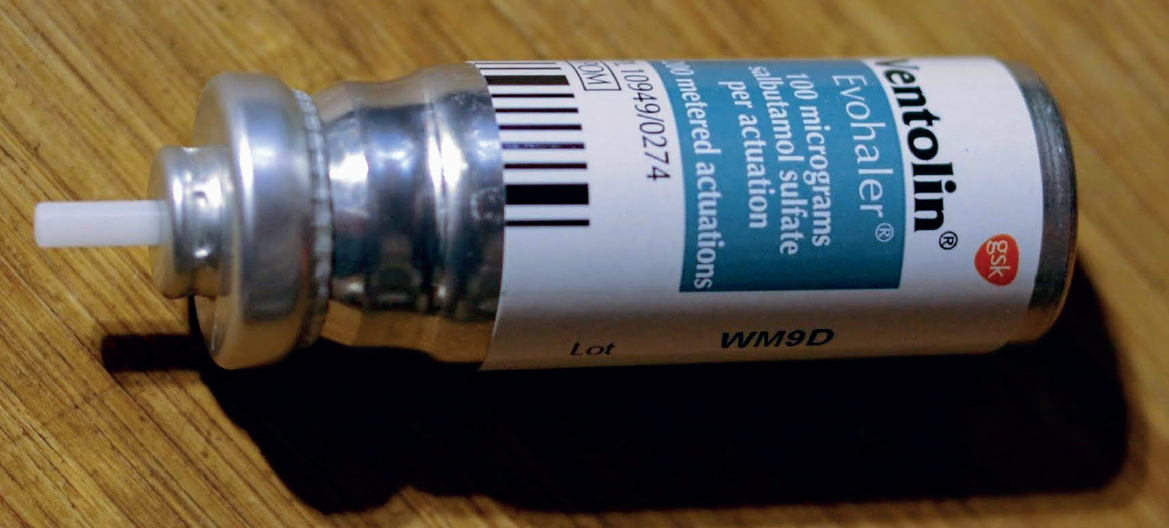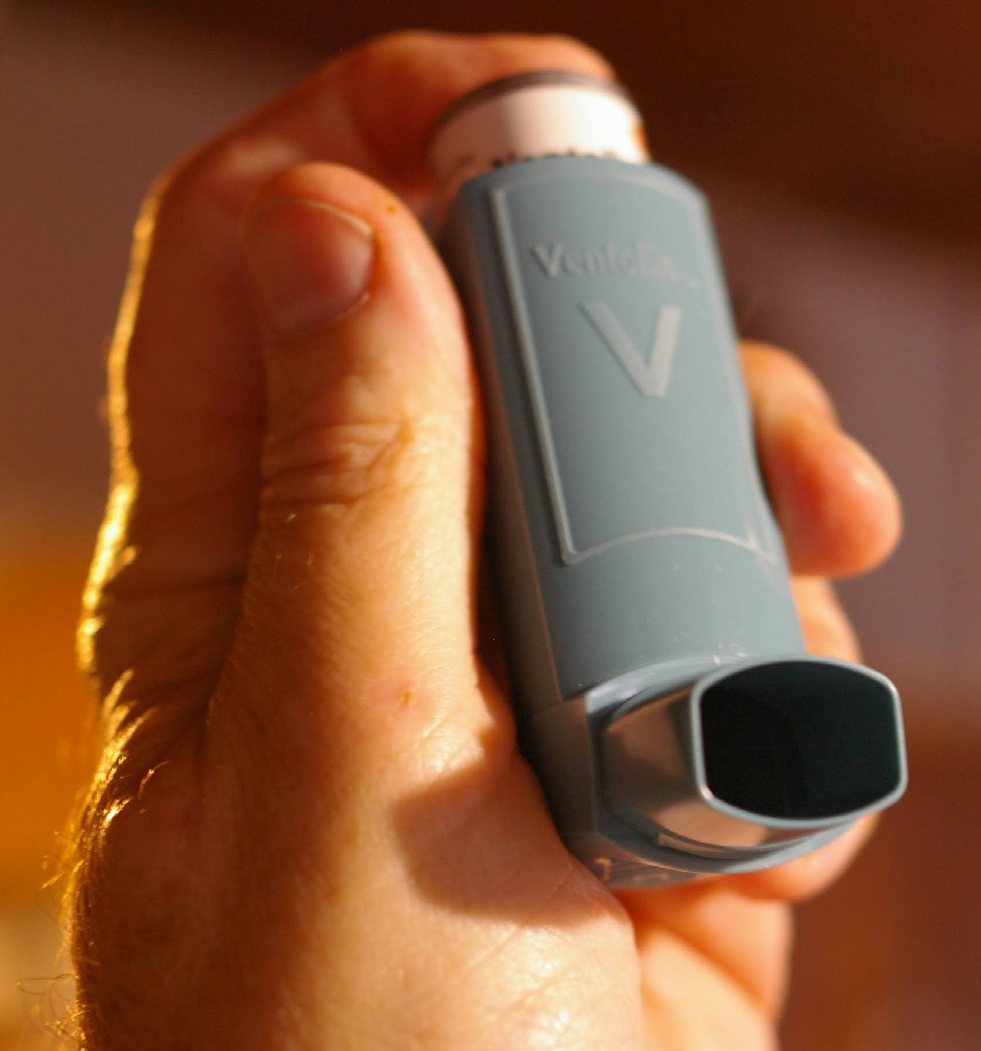Salbutamol (also known as albuterol) is a selective beta2adrenoceptor agonist used as a bronchodilator and, in human medicine, in the management of premature labour. Salbutamol is available in various forms; powders and aerosols are administered by inhalation, and solutions (1 mg/ml) are used in respirators. Nebulisers including metered-dose inhalers (which are usually 100 or 200 mcg/dose and shown in Figure 1) are commonly available. Tablets (2 mg or 4 mg) and syrups (2 mg/5 ml) for oral administration are declining in use and nebulised beta2-adrenoceptor agonists are more commonly used.

Salbutamol products, particularly inhalers (Figure 2), may be left unattended around the home and are readily accessible to pets and easily pierced by them. Salbutamol exposure in dogs can cause pronounced and rapid onset clinical signs, often requiring veterinary intervention and monitoring.

Mechanism of action
Cardiac signs
At therapeutic concentrations, salbutamol is selective for beta2adrenergic receptors, primarily causing relaxation of bronchial, vascular and uterine smooth muscle which is thought to be mediated via the adenylyl cyclase-cyclic adenosine monophosphate (cAMP) system (Sutherland and Rall, 1960). At higher doses, however, beta2 selectivity of salbutamol is reduced, with activation of beta1-adrenergic receptors resulting in cardiovascular stimulation (Stiles and Plumb, 1993; Libretto, 1994). Increases in heart rate include a reflex response to systemic hypotension resulting from salbutamol-induced peripheral and coronary vasodilation (Nayler and McInnes, 1972; Petruska et al, 1997).
Hypokalaemia
Salbutamol can cause hypokalaemia, possibly due to cAMP-mediated stimulation of the Na+/K+ adenosine triphosphate pump (Whyte et al, 1987; Vite and Gfeller, 1994). The decrease in serum potassium is transient and total body potassium does not decrease (Vite and Gfeller, 1994). In metabolic studies, intravenous administration of salbutamol in dogs caused significant hypokalaemia within 60 minutes, however urinary excretion of potassium did not change (Wahlqvist et al, 1978). In an experimental study in dogs, inhaled salbutamol caused a rapid fall in whole blood potassium concentrations. This occurred by 60 minutes with a low dose (90 μg) and 30 minutes with a high dose (450 μg) of salbutamol (Ogrodny et al, 2022).
In case series of dogs with salbutamol toxicosis (varying from 20 to 501 cases) the incidence of hypokalaemia ranged from 20–69% (Bough, 2001; Meroni et al, 2021; Crouchley and Bates, 2022).
Chlorinated fluorocarbons
Some metered-dose inhalers contain chlorinated fluorocarbons as propellants. Chlorinated fluorocarbons can be cardiotoxic at high doses (Stiles and Plumb, 1993) and can also have central nervous system depressant effects (Rosendale and Volmer, 1998), although absorption of chlorinated fluorocarbons through oral administration is low and they are considered of low toxicity (Stiles and Plumb, 1993).
Toxic dose
Most cases of salbutamol toxicosis in dogs are due to puncturing an asthma inhaler. In cases where the salbutamol dose was estimated, 0.33–0.72 mg/kg caused restlessness, tachycardia, tachypnoea, hypokalaemia, weakness and paresis with recovery within 36 hours (Vite and Gfeller, 1994; Rosendale et al, 1998; McCown et al, 2008).
It should be noted that even apparently empty salbutamol cannisters can cause clinically significant adverse effects (Crouchley and Bates, 2022).
Clinical effects
Onset and duration
Clinical effects of salbutamol overdose in dogs occur between 30 minutes and 12 hours post-exposure, but commonly within 4 hours.
Recovery is usually within 8–24 hours. Rarely, effects may persist for 36–48 hours or longer (Crouchley and Bates, 2022). In one case in the literature, cardiac signs persisted for 2 months after exposure to salbutamol (Matos et al, 2012).
Clinical signs
The most common features observed in dogs with salbutamol toxicosis are tachycardia, tachypnoea, vomiting, lethargy, panting, hypokalaemia and tremor (Meroni et al, 2021; Crouchley and Bates, 2022). Owners may report their dog appears restless, distressed or anxious.
Other effects include (Crouchley and Bates, 2022):
- Restlessness
- Polydipsia
- Collapse
- Weakness
- Agitation
- Ataxia
- Hyperthermia
- Excitability
- Hyperaesthesia
- Anxiety
- Dilated pupils
- Peripheral vasodilation
- Twitching
- Incoordination
- Hypersalivation
- Inappetence
- Depression
- Conjunctival hyperaemia
- Thirst
- Vocalisation.
Salbutamol can also cause a transient hyperglycaemia followed by an increase in serum insulin.
Complications
Complications of hypokalaemia include muscle hyperpolarisation, which can result in muscle weakness and flaccid paralysis and has been reported in salbutamol toxicosis in dogs (Vite and Gfeller, 1994; McCown et al, 2008). This may present as hind-limb paresis, progressing to include all four limbs and cervical ventroflexion and dogs can become recumbent (Rosendale and Volmer, 1998). Severe hypokalaemia could result in respiratory muscle paralysis, requiring mechanical ventilation (McCown et al, 2008). Salbutamol-induced hypokalaemia can also cause arrhythmias (Romito et al, 2013) and reduced urinary acid secretion resulting in metabolic acidosis (McCown, 2008). Other complications include cardiovascular collapse and shock, rhabdomyolysis, pigmenturia and acute kidney injury (Granfone and Walker, 2021).
Sequelae
Delayed or more long-term effects are occasionally seen after salbutamol exposure in dogs.
Exposure to released compressed gas from metered-dose inhalors can cause significant oral injury which may be delayed in onset by 24 hours, with oedema, ulceration and erythema of the soft palate, extensive pharyngeal and laryngeal oedema, resulting in respiratory distress (Mackenzie et al, 2012).
Persistent extrasystoles, phases of idioventricular rhythm of slow heart rate and paroxysmal ventricular tachycardia, persisting up to 2 months have been reported following exposure to salbutamol, despite correction of hypokalaemia within 19 hours after exposure. The dog required prolonged treatment with a beta-blocker, and the injury was thought to be caused by acute myocardial damage as evidenced by markedly elevated serum troponin 1 concentrations. It is worth noting that in this case the diagnosis was made with a long-term Holter electrocardiogram and may not have been identified with a short electrocardiogram strip (Matos et al, 2012).
Treatment
All dogs that puncture a salbutamol inhaler should be seen and assessed by a veterinary surgeon.
Gut decontamination
Gut decontamination is only indicated if salbutamol has been ingested and it is within 30 minutes. An emetic and a single dose of activated charcoal can be given.
Monitoring and observation
Dogs that have been exposed to salbutamol should have their heart rate, blood pressure and electrocardiogram monitored (Stiles and Plumb, 1993). They should be hospitalised until the heart rate and rhythm, central nervous system status and electrolytes normalise. Hospitalised dogs required regular physical examination, particularly if recumbent, for signs of oral injury or muscle damage.
The electrolytes (particularly potassium) and blood glucose should be monitored. Caution is advised when administering intravenous fluids without measuring the potassium concentration as intravenous fluid therapy may further dilute potassium and exacerbate signs of hypokalaemia (Vite and Gfeller, 1994). In dogs with significant clinical signs or delayed presentation, the cardiac troponin, creatine kinase, liver enzymes and renal function should be assessed.
Initial management
Intravenous fluids can be given for shock or collapse, if appropriate, with monitoring of electrolytes. Intravenous fluids will also help prevent complications such as acute kidney injury secondary to rhabdomyolysis.
Management of tachycardia and arrhythmias
If salbutamol-induced tachycardia is prolonged or severe, or if there are signs of reduced cardiac output (pale mucous membranes, weak pulses, cold extremities (Stiles and Plumb, 1993)), then drug therapy is recommended. A beta-blocker should be given if the heart rate is more than 180–200 bpm (Rosendale and Volmer, 1998).
Propranolol is preferred as it is a non-selective beta1 and beta2-agonist and will help control systemic signs, hypokalaemia and cardiac effects. An intravenous beta-blocker will have a more rapid onset of action, but an oral formulation can be used if a parenteral product is not available. Esmolol has also been used in dogs with salbutamol toxicosis (Verschoor-Kirss et al, 2021). Alternatives include metoprolol and atenolol.
If arrhythmias are present following beta-blocker administration, lidocaine can be given (Mitten et al, 1999), but potassium concentrations should be monitored closely as lidocaine will not be effective against hypokalaemia (Mitten et al, 1999).
Management of hypokalaemia
Salbutamol causes a transient decrease in serum potassium, but this does not reflect a decrease in total body potassium. Therefore, a beta-blocker is a more specific treatment for salbutamol-induced hypokalaemia than potassium supplementation (Vite and Gfeller, 1994). As outlined earlier, a non-specific beta-blocker is preferred.
Intravenous potassium supplementation is appropriate if the potassium concentration falls below 2.5 mmol/L. The potassium concentration should be checked again in 6 hours and the administration rate adjusted in line with serum potassium concentrations. If possible, the electrocardiogram should be monitored because of the risk of hypokalaemia-induced arrhythmias.
Monitoring and management of sequelae
Oral injury from chlorinated fluorocarbons may take 24 hours to develop, so if the dog is discharged, the owner should be advised to observe for any signs associated with oral injury (inappetence, anorexia, adipsia, dysphagia, respiratory distress) and to return if they occur (Mackenzie et al, 2012). Management is supportive.
Aggressive potassium supplementation may result in rebound hyperkalaemia which may require dextrose-insulin therapy.
Arrhythmias (such as transient paroxysmal ventricular tachycardia) may persist after correction of hypokalaemia and could last up to 2 months post-exposure. In a case reported in the literature, the diagnosis was made with a long-term Holter electrocardiogram and may not have been identified with a short electrocardiogram strip (Matos et al, 2012). If myocardial injury is suspected or confirmed (elevated troponin concentrations) and there are persistent arrhythmias, an antiarrhythmic drug (like propranolol) may be required.
Conclusions
Most dogs exposed to salbutamol develop rapid onset clinical signs, but fatalities are uncommon. In most cases dogs bite and puncture a salbutamol inhaler and medical assessment is recommended for all dogs with accidental salbutamol exposure. Common clinical signs are tachycardia, lethargy and transient hypokalaemia. Treatment is aimed at correcting tachycardia and hypokalaemia, usually with a beta-blocker. Potassium supplementation is not the first-line management of salbutamol-induced hypokalaemia. Recovery generally occurs within 24 hours, but there is risk of persistent cardiac injury.
KEY POINTS
- Dogs are commonly exposed to salbutamol from puncturing an asthma inhaler.
- All dogs exposed to a salbutamol inhaler require evaluation.
- Common signs of salbutamol toxicosis are tachycardia, tachypnoea and hypokalaemia.
- A non-selective beta-blocker is the treatment of choice for tachycardia and hypokalaemia.
- Salbutamol exposed dogs require hospitalisation until the heart rate and rhythm, central nervous system status and electrolytes normalise.
- Prognosis is good in dogs with salbutamol toxicosis; complications and sequelae are uncommon.


